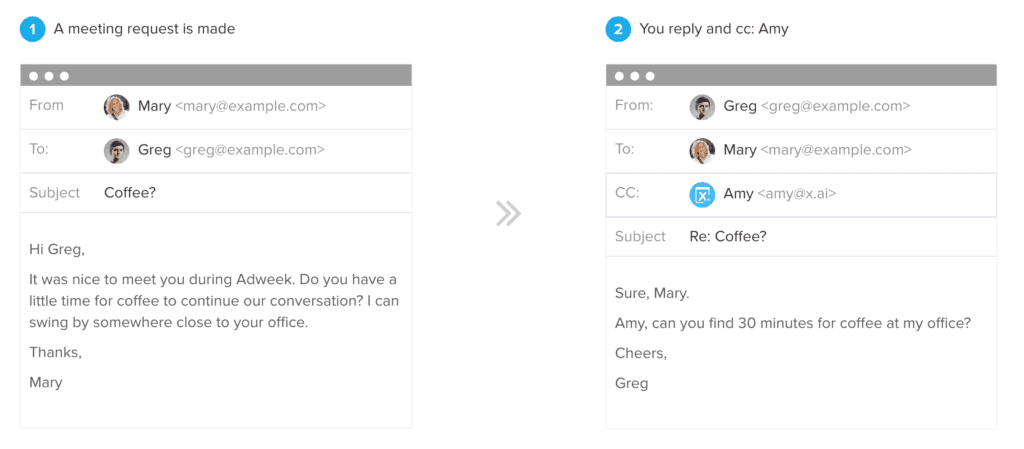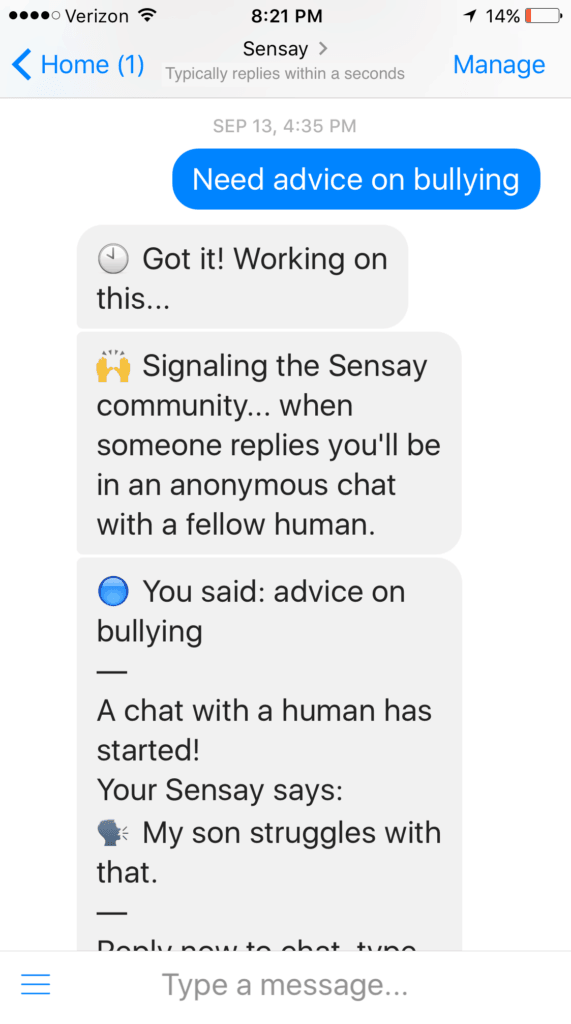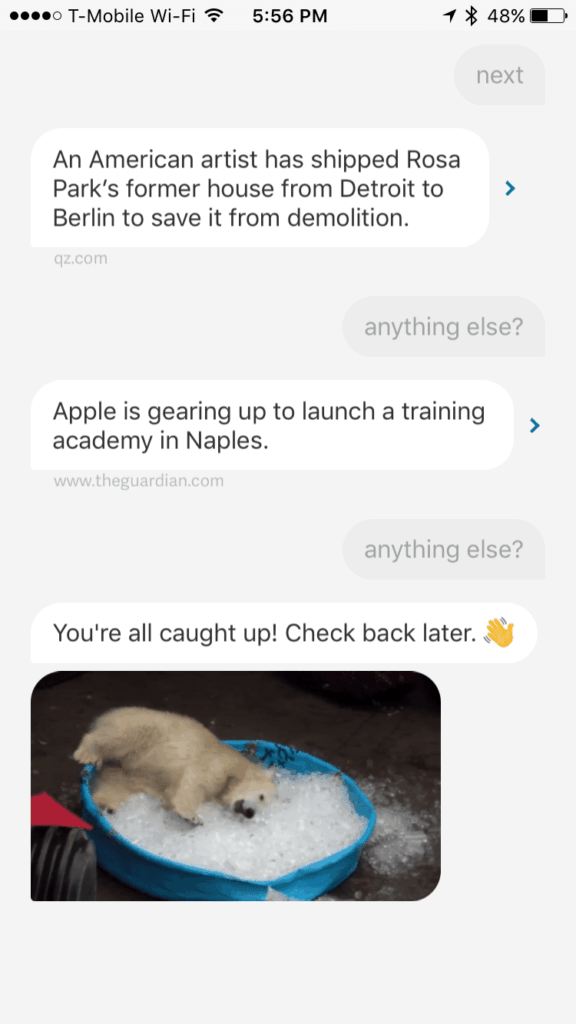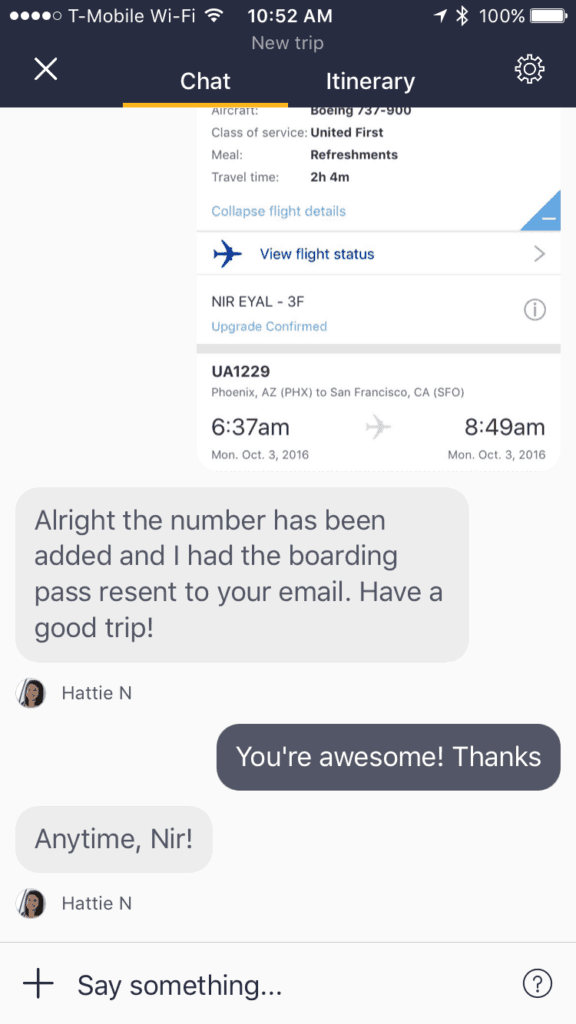Recently, I needed to book a lunch meeting. To help coordinate, I asked Amy to assist and cc’d her on the email. “Amy,” I wrote, “please help us find a time to meet. Let’s plan for sushi at Tokyo Express on Spear Street.” Amy looked at my calendar, found an open time suitable for everyone invited, and booked the meeting.
Amy works just like a human assistant, except she’s not human. It’s an AI bot made by X.ai, a company specializing in scheduling assistants that respond to natural language. Amy is so good at what she does that I find myself thanking her for booking a meeting, forgetting she needs no more thanks than my microwave.

It’s easy to forget Amy, an artificial intelligence bot made by X.ai, isn’t human. Image source: x.ai
It’s impossible to ignore all the buzz about AI bots. Last month, Facebook’s David Marcus announced that over 30,000 bots have been built since the opening of its Messenger app to bot developers in April. Other companies like Google, Amazon, and Slack are welcoming bot-building developers to their platforms with open arms. Slack even created an $80 million fund to support chatbot projects.
As with any tech trend, most companies building bots today won’t survive. However, some are bound to have a massive impact and will profoundly change the way we interact with our software and services.
The deciding factor between which bots will live and which will die is how well they keep users engaged. After all, if a personal technology isn’t habitually used, it is easily forgotten. Since most bot companies are built on other companies’ platforms, like Facebook Messenger, Amazon Echo, WeChat, and Slack, they must stay top of mind or they may as well not exist.
So what makes for an engaging bot — one that users come back to again and again?
Beyond Bots
First, it is helpful to expand the scope beyond what most people call “bots” and consider a much larger and more interesting technological shift. Although “bots” has become a buzzword for the artificial intelligence powering many fledgling services, that’s only part of the story. It’s the way we interact with these bots — and the way they are designed for those interactions — that makes them special.
An AI Bot uses a Conversational User Interface (CUI) to turn the tediousness of tapping through drop-downs and app menus into the simple act of asking. On a screen, a CUI looks like a text message, an interface anyone with a mobile phone understands. However, it’s important to remember that CUIs don’t necessarily require a screen at all.
CUIs can work beautifully through a voice exchange. In the best cases, communicating with a CUI by just talking should feel like a chat with a good friend or a helpful assistant. In fact, science fiction inspiration like Jarvis, the virtual butler from “Iron Man,” or Samantha, the digital companion in the movie “Her,” is where enthusiasts hope this technology is headed.

Conversational User Interfaces (CUIs) turn the tediousness of tapping through drop-downs and app menus into the simple act of asking. Image credit: ThinkMobiles
Engaging Conversation
If communicating with CUIs is going to be as simple as talking to a good friend, we should design them as such. William Rawlins, a professor of Interpersonal Communication at Ohio University who studies friendship, says a friend has three qualities: they’re easy to talk to, enjoyable, and dependable. We form routines around turning to important people in our lives in the same way we build habits with our technologies.
In my book, “Hooked: How to Build Habit-Forming Products,” I describe a four-step model that companies utilize to keep users coming back — a trigger, action, reward, and investment. Hooks are the reason we check our tech hundreds of times per day with little or no conscious thought. Integrating the Hooked Model with Rawlins’ three qualities of a good friend provides important insights into designing engaging technology that feels familiar and is the key to building great CUIs.

The same “hook” that makes products habit-forming is also what makes friendships last.
The first step to changing habits is identifying what I call an “internal trigger.” Internal triggers are the momentary psychological pain we feel right before we use a product. It’s why we check Facebook when we’re lonely, why we Google when we’re uncertain, and why we watch YouTube videos when we’re tired after work. These services have bolted themselves onto frequently felt negative emotions. The same goes for calling upon a friend and, by extension, using a CUI.
For example, Sensay.co uses an AI bot to put strangers in touch with one another. The company serves over 1.5 million people across messenger services and SMS. CEO Ariel Jalali told me the company wants to “be the first place people go to when they feel bored or indecisive and want to connect with someone with relevant experience.”
Whether it’s looking for a quick recommendation or a lengthier conversation with an anonymous new friend, Sensay.co wants to serve users whenever they feel the frequently occurring need for a social connection. Sensay.co is an example of a company that uses people, combined with a back-end AI bot, to scratch its users’ itch with a simple, conversational interface.

Sensay.co uses text messages to quickly connect strangers in need. Image source: Sensay.co
Easy To Talk To
The next step of the Hooked Model is the “action phase” — a simple behavior that might yield a reward, like scrolling the feed on Facebook. Like a friend, a CUI needs to be easy to talk to. It’s in the action phase that well-designed CUIs can surpass their traditional app cousins. CUIs can present information and functionality exactly when it’s needed, without requiring the user to tap through complicated menus and options or exit one app, like email, to get the task done somewhere else, like a calendar.
For example, as part of the recent fanfare around Google’s new Pixel phone, the company showcased how the Google Assistant provides helpful information at just the right time by integrating with different services. If two people text about a restaurant, the Google Assistant can provide directions with Google Maps and make a reservation through OpenTable, all from within the conversation. By anticipating what’s needed and bringing disparate services together, the CUI makes communication a breeze.
If you’re looking for even more research on this topic, then I invite you to download our 18-lesson PDF course on Product Psychology:
Enjoyable
Next in the Hooked Model comes the reward. The reward gives users what they came for, scratching their itch, and yet leaves them wanting more. Just as we keep engaging with friends who are fun to be around, a good CUI keeps us on our toes.
For example, one of my daily habits is using Quartz, the news service that looks like a simple conversation. Quartz is both enjoyable and easy to talk to in a number of ways.
First, Quartz inserts funny quips and gifs to keep me engaged while I read the news. However, Quartz doesn’t ask for too much. The CUI gives me the news in quickly consumed tidbits without forcing me to click through to an article to get the most important information. Unlike other news sites, Quartz doesn’t care if I read the entire article and understands I just want to know the gist of the top stories. If I want to get the entire story, I can follow the link, but I rarely do.
Furthermore, while other news sites try to keep me scrolling through articles forever so they can rack up ad revenue, the Quartz CUI literally tells me to go away when it’s done giving me the most important stories, saying, “You’re all caught up! Check back later.”
By giving me a sense of completion that I’m caught up on the day’s news, Quartz gives me exactly what I want. While other news sites feel like a nagging librarian telling what I should be reading, Quartz is easier to talk to and more enjoyable because it demands less of my time and attention while keeping me engaged with humor and surprise.

Quartz uses a CUI to tell me when I’m “all caught up!” on the day’s news.
Dependable
Imagine you meet your friend for lunch. You sit together and as you enjoy your meal, you tell each other about what’s happening in your life. You open up and make yourself a bit vulnerable. Being vulnerable brings people closer together and you leave the lunch thankful for the relationship.
Now imagine that the next time you see your friend, they don’t remember a word you told them. Everything you disclosed seems to have vanished from their memory or, worse yet, they didn’t pay attention to what you said in the first place. Unless they suffer from amnesia, this is not the kind of friend you’d like to keep around.
According to Rawlins’ research, a good friend is dependable. Relationships can’t grow unless people invest in each other. We expect our investment to yield a return in the form of shared information and a history — which make us more efficient at understanding and anticipating our friends’ wants and needs. The same is true of our technology.
The fourth and final step of the Hooked Model is the “investment phase.” This is where, like in a friendship, we put something into the service in expectation that it will improve over time. Far too many products don’t ask for investment or they don’t reward it, collecting but never reinvesting the information that users share. But the CUI makes asking for and integrating user investment much easier and more useful.
For example, the more I use Pana, a travel service utilizing a CUI, the better it becomes. (Full disclosure: I loved the service so much, I invested in the company.) Pana remembers my preferences every time I use it. Where do I like to sit on the plane? What’s my frequent flyer number? Which credit card do I use for business versus personal travel? The list goes on.
However, unlike a traditional app or website that would ask for all this information up front, Pana asks for it as needed, but remembers it for life. Like a good friend, Pana doesn’t ask me to repeat myself. With all that information, Pana can be helpful in ways no other travel service can.
Pana can tell me, for example, when I should buy a ticket with points versus cash and handles the transaction for me. Another case in point: Last week, on the way to Phoenix from San Francisco, I noticed I’d forgotten to enter my TSA Precheck number into my flight reservation. Instead of having to call the airline, wait on hold, and negotiate with the representative, I sent a quick text to Pana and it was done for me.

A quick message sent on Pana saved me the hassle of calling the airline.
Want to learn more about this topic? I’ve teamed up with a panel of experts to create a product psychology course. Download our 18-lesson PDF course and dive right in:
CUI + You = BFF
Amy, the AI bot that booked my lunch meeting, is an example of a CUI that saves time by doing things that a traditional interface of menus and buttons can’t. The proof of Amy’s helpfulness is that, although she’s not human, I can’t help interacting with her as if she were. Amy and the other examples above are just the beginning. In the years to come, CUIs are going to change our lives for the better by treating us like friends.
Of course, friends must help each other. Likewise, the service provided by a new technology must be genuinely helpful. As my friend Amir Shevat of Slack told me, “no matter how good the bot or CUI is, it cannot compensate for a shitty service.” But when built well, CUIs can leverage the four steps of a habit-forming product and create bonds between the user and the technology. By designing services that are enjoyable, dependable, and easy to talk to, companies can build products that feel familiar even when we are using them for the first time.
Nir’s Note: This article is co-authored by Nir Eyal and Alexis Safarikas. Nir Eyal is the author of “Hooked: How to Build Habit-Forming Products” and blogs about the psychology of products at NirAndFar.com. Alexis Safarikas is a digital strategist at Springbok.
Related Articles
- Schedule Maker: a Google Sheet to Plan Your Week
- Cancel the New York Times? Good Luck Battling “Dark Patterns”
- How to Start a Career in Behavioral Design
- A Free Course on User Behavior
- User Investment: Make Your Users Do the Work
- Variable Rewards: Want To Hook Users? Drive Them Crazy
- The Hooked Model: How to Manufacture Desire in 4 Steps

